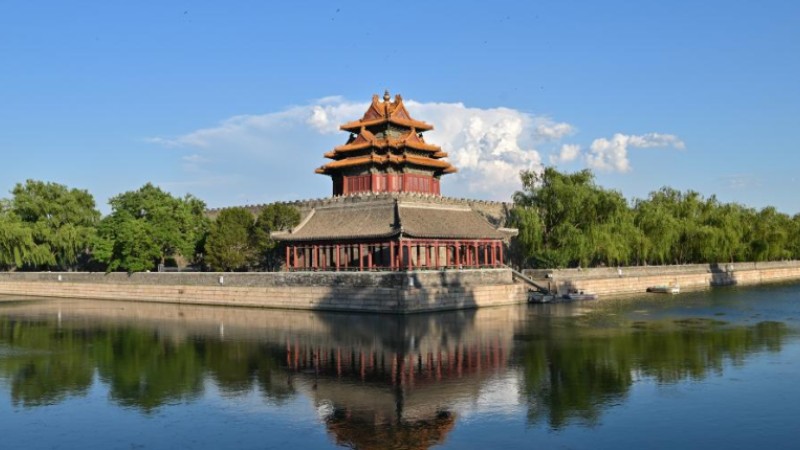Barren deserts in NW China's Xinjiang turning into major production base of green electricity
As the new energy industry picks up, barren desert areas in northwest China's Xinjiang Uygur Autonomous Region, where not even a blade of grass grows, are yielding rich fruits in the generation of electricity using renewable energy sources.

Aerial photo taken on Aug. 22, 2021 shows heliostats at a photothermal power station in Hami, northwest China's Xinjiang Uygur Autonomous Region. (Xinhua/Gao Han)
Boasting extraordinary advantages of rich wind and solar energy resources, Xinjiang has vigorously boosted the development of renewable energy sources to continuously promote the adjustment of its energy structure in recent years.
By speeding up the construction of large-scale wind power and photovoltaic (PV) power bases in sandy areas, rocky areas and deserts, the region has realized the large-scale and intensive development and utilization of new energy sources and constantly expanded its new energy industry.
As of July 13, Xinjiang's total installed capacity of new energy hit 50.26 million kilowatts (kW), according to data from the State Grid Xinjiang Electric Power Co., Ltd.
In the first half of the year, the newly installed new energy capacity in the region reached nearly 7.02 million kW, which is 10.5 times higher than the same period last year.
So far, Xinjiang has completed the construction of a new energy base with an annual power generation capacity of over 10 million kW in Hami city, and built more than 10 new energy clusters, with each having an annual power generating capacity of more than 1 million kW, said Li Chenyang, head of the regional energy bureau.
A good number of major new energy projects with a combined capacity of more than 70 million kW are under construction in the region, according to Li.
In the Hami high-tech industrial development zone, the first phase of a project on the manufacturing of single-crystal silicon rods and N-type silicon wafers has entered the final phase of construction.
With a designed annual capacity of 10 gigawatts (GW) of single-crystal silicon rods and N-type silicon wafers, and an investment of 4.02 billion yuan, ($560 million), the first phase of the project is expected to provide about 1,300 jobs for local people and produce 1.7 billion yuan worth of products a year, said Zhou Yanming, manager of the project.
In Fukang city, Changji Hui Autonomous Prefecture of Xinjiang, the construction of a multi-energy complementary project invested by Luneng Group, a Chinese real estate and new energy conglomerate, is in full swing.
The project features a development model that combines PV power generation and photo-thermal power generation with desertification control, which will fully magnify the ecological and economic benefits, according to Xu Tao, executive manager of the project.
When completed, the project will help address desertification on 37,000 mu (2,467 hectares) of areas and comprehensively improve the economic efficiency of the local new energy, culture, tourism, agriculture and animal husbandry, and energy storage industries, Xu noted.
By advancing the coordinated development and fostering synergy between its new energy industry and other related industries, Xinjiang has significantly extended, improved and enhanced its new energy industry chain, accelerating the formation of a complete industry chain of the new energy industry.
Li said the region has rolled out policies to facilitate the development of the new energy industry and related industries, ramping up efforts to promote the high-quality development of pumped-storage hydropower projects, establishing and improving new-type energy storage facilities, and advancing the construction of projects integrating power supply, grid, load and energy storage to ensure the systematic and coordinated development of various links of power generation, transmission, storage and consumption.
These favorable policies have attracted many large companies to the region. Since 2022, more than 70 well-known Chinese companies, including China Huadian Corporation and China Energy Engineering Corporation, have settled a host of PV power projects in the region, putting the local new energy industry on a fast track of development.
As an important base of China's west-to-east power transmission program, Xinjiang has also made continuous efforts to expand its channels for power transmission and improve market mechanisms, so that its green energy sources can benefit more people across the country.
The region will soon kick off an ultra-high voltage direct current power transmission project that sends electricity from Hami to southwest China's Chongqing Municipality. The project is expected to increase the annual amount of electricity supplied by Xinjiang to other regions of the country by more than 40 billion kilowatt-hours (kWh).
In the first five months of the year, Xinjiang sent about 16.72 billion kWh of electricity produced from new energy sources to other regions of the country, which accounted for more than 30 percent of the total amount of electricity transmitted from the region during the period.
Photos
Related Stories
- China's plateau province sees remarkable surge in new energy product exports in H1
- New-energy industry in SW China's Guizhou logs steady expansion
- Xinjiang's installed capacity of new energy up 20.7 percent
- China's new energy power project in desert area becomes operational
- China's annual power generation from wind, solar energy surpasses 1 tln kWh in 2022
- China's Hebei sees growing new energy power generation capacity
- Chinese new energy buses gallop into Arab market
- China's power battery output surges 98.1 pct in October
Copyright © 2023 People's Daily Online. All Rights Reserved.









